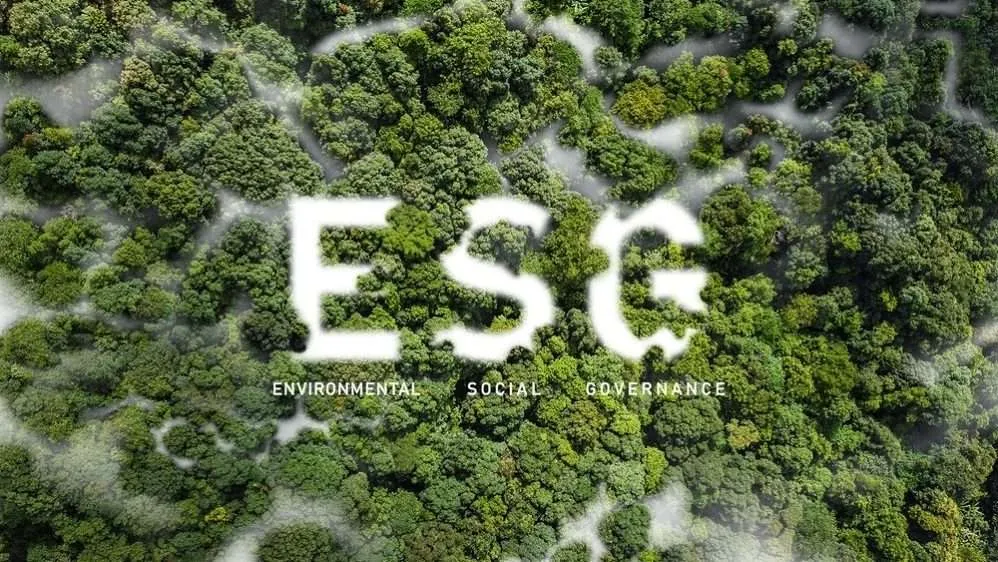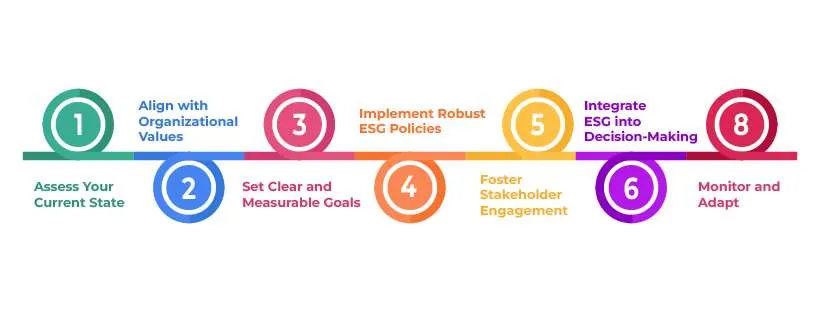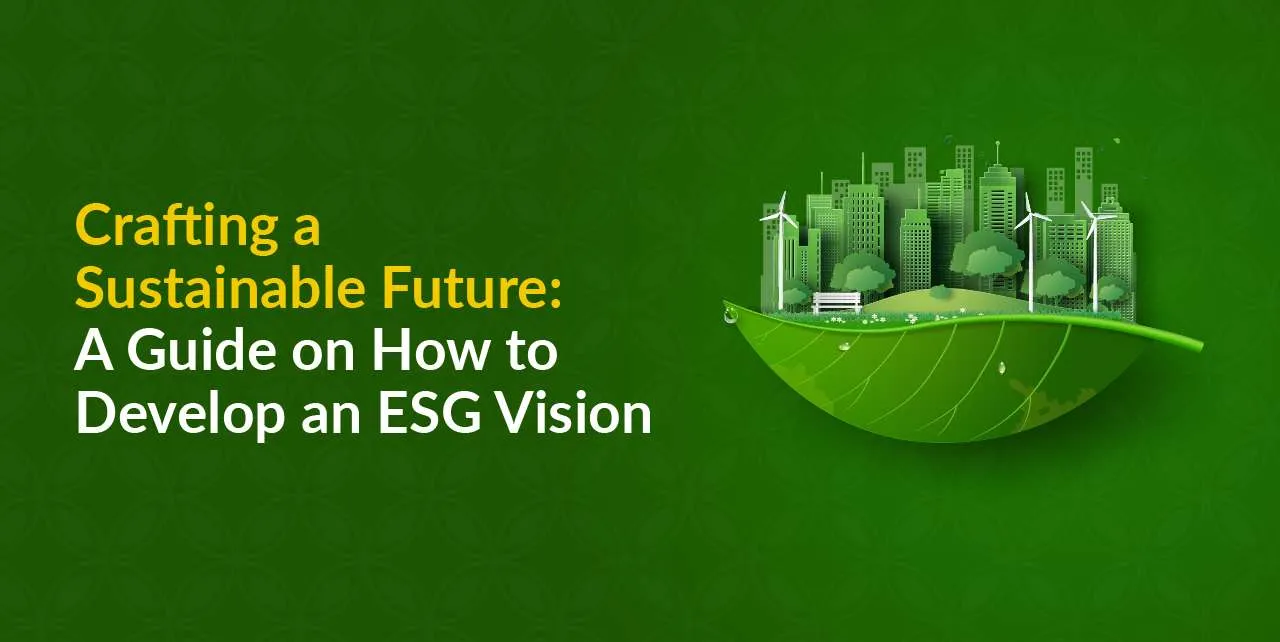Crafting a Sustainable Future: A Guide on How to Develop an ESG Vision
In today’s rapidly evolving business landscape, environmental, social, and governance (ESG) considerations have become integral to a company’s long-term success. Developing a clear and comprehensive ESG vision is not only a strategic business move but also a commitment to creating a positive impact on the planet and society. In this guide, we’ll explore the essential steps to help you develop a robust ESG vision for your organisation.
Understanding ESG
Before delving into the development process, it’s crucial to understand the core elements of ESG. ESG refers to the three central factors that measure the sustainability and ethical impact of an investment or business. Let’s break down each component:
1. Environmental (E): Focuses on a company’s impact on the planet. This includes its carbon footprint, energy efficiency, waste management, and overall commitment to environmental stewardship.
2. Social (S): Examines a company’s relationships with its employees, customers, communities, and other stakeholders. It involves considerations such as diversity and inclusion, labor practices, human rights, and community engagement.
3. Governance (G): Addresses the structure and practices that guide a company’s decision-making processes. This encompasses board composition, executive compensation, shareholder rights, and adherence to ethical business practices.
What is an ESG Vision?

ESG metrics, a relatively recent concept, have gained significance amid growing concerns about climate change, depleting natural resources, economic inequality, and reporting fraud. Companies emphasizing ESG factors gain a competitive edge and position themselves for sustained success. To ensure business longevity and success, it is crucial to establish an ESG Vision. To garner internal support for your program’s success, prioritize assembling a team of cross-functional stakeholders capable of identifying and assessing ESG risks, opportunities, and performance from various perspectives within your company.
Relevance of an ESG Vision for Companies or Organizations
1. Enhance the long-term viability and efficiency of your company’s operations. Companies with robust ESG practices can achieve cost savings in areas like energy consumption, water usage, and waste disposal. McKinsey reported a 60% increase in profits for companies with ESG targets, coupled with equivalent cost reductions.
2. Align with consumer preferences and investor expectations. Shoppers and investors increasingly favor ethical and sustainable companies. To maintain popularity, companies must demonstrate a commitment to community and environmental concerns. Notably, 62% of Generation Z and 50% of millennials prefer supporting ethical companies.
3. Boost business resilience and mitigate risks such as supply chain disruptions, regulatory compliance challenges, and reputational harm by considering ESG factors. Prioritizing ESG issues equips companies to navigate volatile markets more effectively.
Developing an ESG Vision

Step 1: Assess Your Current State
To develop a meaningful ESG vision, start by conducting a thorough assessment of your current environmental, social, and governance practices. Identify strengths, weaknesses, opportunities, and potential threats. Engage with stakeholders, including employees, customers, investors, and local communities, to gather diverse perspectives on your organisation’s impact. Learn the art of listening to diverse perspectives, aligning interests, and identifying areas for improvement.
Consider partnering with external experts or sustainability consultants to conduct an ESG audit. This audit will provide an unbiased evaluation of your current practices and help identify areas where improvement is needed.
Step 2: Align with Organizational Values
Your ESG vision should align seamlessly with your organisation’s core values and mission. Clearly articulate how sustainability and ethical practices support your overall business objectives. This alignment not only reinforces your commitment but also ensures that your ESG vision becomes an integral part of your corporate culture. Engage with key decision-makers, including executives and board members, to ensure that the ESG vision is embraced at the highest levels of the organisation. Foster a sense of ownership and responsibility throughout the company to drive meaningful change.
Step 3: Set Clear and Measurable Goals
Developing an ESG vision requires setting concrete, measurable and time-bound goals to track progress and demonstrate accountability. Establish key performance indicators (KPIs) for each ESG component to ensure a comprehensive approach. For example, set targets for reducing carbon emissions, increasing diversity in leadership roles, or enhancing board transparency.
Step 4: Implement Robust ESG Policies
Once your goals are established, it’s time to implement robust ESG policies that guide decision-making at every level of the organisation. These policies should address environmental impact, social responsibility, and governance practices. Ensure that employees are educated on these policies, and integrate them into training programs to foster a culture of sustainability and ethical conduct. Consider adopting international frameworks and standards, such as the Global Reporting Initiative (GRI) or the Sustainability Accounting Standards Board (SASB), to enhance the credibility and transparency of your ESG reporting.
Step 5: Foster Stakeholder Engagement
Effective stakeholder engagement is a cornerstone of successful ESG development. Regularly communicate your organisation’s progress, challenges, and successes to stakeholders through various channels, including annual reports, sustainability reports, and dedicated ESG websites. Create mechanisms for ongoing dialogue with stakeholders to gather feedback, address concerns, and adapt your ESG strategy accordingly. This two-way communication not only enhances transparency but also ensures that your organisation remains responsive to evolving expectations and priorities.
Step 6: Integrate ESG into Decision-Making
To embed sustainability into the fabric of your organisation, integrate ESG considerations into the decision-making process. Whether it’s evaluating investment opportunities, product development, or supply chain management, ensure that ESG factors are consistently assessed and incorporated into strategic decisions. Encourage collaboration across departments to break down silos and foster a holistic approach to sustainability. By incorporating ESG into day-to-day operations, your organisation can create lasting positive change.
Step 7: Monitor and Adapt
Sustainability is a dynamic field, and a successful ESG vision requires continuous learning, regular monitoring and adaptation. Implement a robust monitoring system to track progress against established goals and identify areas for improvement. Regularly reassess your ESG strategy to ensure it remains aligned with emerging trends, regulations, best practices and stakeholder expectations. Adaptability is key in the dynamic landscape of sustainability. Embrace innovation and stay informed about advancements in sustainable practices, technologies, and regulatory frameworks. This proactive approach positions your organisation as a leader in the ever-evolving ESG landscape.
Developing a meaningful ESG vision is not just a box to check; it’s a transformative journey that positions your organisation as a responsible and forward-thinking entity. By assessing your current state, aligning with organisational values, setting clear goals, implementing robust policies, fostering stakeholder engagement, integrating ESG into decision-making, and monitoring progress, you can craft a sustainable future for your organisation, leaving a positive impact on the environment, society, and governance practices. Embrace the challenge and seize the opportunity to create lasting value for your business and the world.


